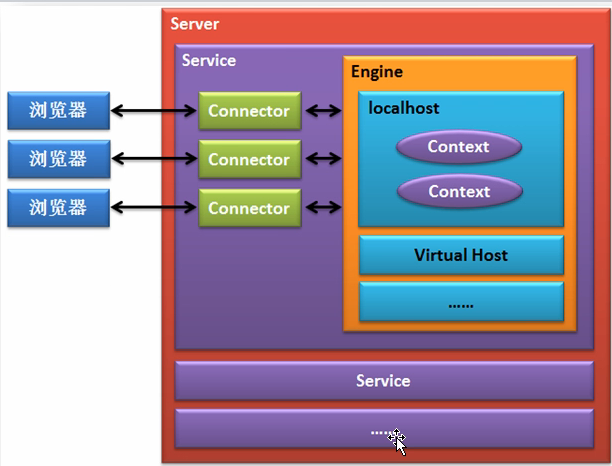2017-12-01 15:16:47
一、Tomcat简介
Tomcat 服务器是一个免费的开放源代码的Web 应用服务器,Tomcat是Apache 软件基金会(Apache Software Foundation)的Jakarta 项目中的一个核心项目,它早期的名称为catalina,后来由Apache、Sun 和其他一些公司及个人共同开发而成,并更名为Tomcat。Tomcat 是一个小型的轻量级应用服务器,在中小型系统和并发访问用户不是很多的场合下被普遍使用,是开发和调试JSP 程序的首选,因为Tomcat 技术先进、性能稳定,成为目前比较流行的Web 应用服务器。Tomcat是应用(java)服务器,它只是一个servlet容器,是Apache的扩展,但它是独立运行的。
Tomcat不是一个完整意义上的Jave EE服务器,它甚至都没有提供对哪怕是一个主要Java EE API的实现;但由于遵守apache开源协议,tomcat却又为众多的java应用程序服务器嵌入自己的产品中构建商业的java应用程序服务器,如JBoss和JOnAS。尽管Tomcat对Jave EE API的实现并不完整,然而很企业也在渐渐抛弃使用传统的Java EE技术(如EJB)转而采用一些开源组件来构建复杂的应用。这些开源组件如Structs、Spring和Hibernate,而Tomcat能够对这些组件实现完美的支持。
二、Tomcat常见组件
1、服务器(server):Tomcat的一个实例,通常一个JVM只能包含一个Tomcat实例;因此,一台物理服务器上可以在启动多个JVM的情况下在每一个JVM中启动一个Tomcat实例,每个实例分属于一个独立的管理端口。这是一个顶级组件。
2、服务(service):一个服务组件通常包含一个引擎和与此引擎相关联的一个或多个连接器。给服务命名可以方便管理员在日志文件中识别不同服务产生的日志。一个server可以包含多个service组件,但通常情下只为一个service指派一个server。
连接器类组件:
3、连接器(connectors):负责连接客户端(可以是浏览器或Web服务器)请求至Servlet容器内的Web应用程序,通常指的是接收客户发来请求的位置及服务器端分配的端口。默认端口通常是HTTP协议的8080,管理员也可以根据自己的需要改变此端口。一个引擎可以配置多个连接器,但这些连接器必须使用不同的端口。默认的连接器是基于HTTP/1.1的Coyote。同时,Tomcat也支持AJP、JServ和JK2连接器。
容器类组件:
4、引擎(Engine):引擎通是指处理请求的Servlet引擎组件,即Catalina Servlet引擎,它检查每一个请求的HTTP首部信息以辨别此请求应该发往哪个host或context,并将请求处理后的结果返回的相应的客户端。严格意义上来说,容器不必非得通过引擎来实现,它也可以是只是一个容器。如果Tomcat被配置成为独立服务器,默认引擎就是已经定义好的引擎。而如果Tomcat被配置为Apache Web服务器的提供Servlet功能的后端,默认引擎将被忽略,因为Web服务器自身就能确定将用户请求发往何处。一个引擎可以包含多个host组件。
5、主机(Host):主机组件类似于Apache中的虚拟主机,但在Tomcat中只支持基于FQDN的“虚拟主机”。一个引擎至少要包含一个主机组件。
6、上下文(Context):Context组件是最内层次的组件,它表示Web应用程序本身。配置一个Context最主要的是指定Web应用程序的根目录,以便Servlet容器能够将用户请求发往正确的位置。Context组件也可包含自定义的错误页,以实现在用户访问发生错误时提供友好的提示信息。
被嵌套类(nested)组件:
这类组件通常包含于容器类组件中以提供具有管理功能的服务,它们不能包含其它组件,但有些却可以由不同层次的容器各自配置。
7、阀门(Valve):用来拦截请求并在将其转至目标之前进行某种处理操作,类似于Servlet规范中定义的过滤器。Valve可以定义在任何容器类的组件中。Valve常被用来记录客户端请求、客户端IP地址和服务器等信息,这种处理技术通常被称作请求转储(request dumping)。请求转储valve记录请求客户端请求数据包中的HTTP首部信息和cookie信息文件中,响应转储valve则记录响应数据包首部信息和cookie信息至文件中。
8、日志记录器(Logger):用于记录组件内部的状态信息,可被用于除Context之外的任何容器中。日志记录的功能可被继承,因此,一个引擎级别的Logger将会记录引擎内部所有组件相关的信息,除非某内部组件定义了自己的Logger组件。
9、领域(Realm):用于用户的认证和授权;在配置一个应用程序时,管理员可以为每个资源或资源组定义角色及权限,而这些访问控制功能的生效需要通过Realm来实现。Realm的认证可以基于文本文件、数据库表、LDAP服务等来实现。Realm的效用会遍及整个引擎或顶级容器,因此,一个容器内的所有应用程序将共享用户资源。同时,Realm可以被其所在组件的子组件继承,也可以被子组件中定义的Realm所覆盖。
引擎(Engine):引擎是指处理请求的Servlet引擎组件,即Catalina Servlet引擎,它从HTTPconnector接收请求并响应请求。它检查每一个请求的HTTP首部信息以辨别此请求应该发往哪个host或context,并将请求处理后的结果返回的相应的客户端。严格意义上来说,容器不必非得通过引擎来实现,它也可以是只是一个容器。如果Tomcat被配置成为独立服务器,默认引擎就是已经定义好的引擎。而如果Tomcat被配置为Apache Web服务器的提供Servlet功能的后端,默认引擎将被忽略,因为Web服务器自身就能确定将用户请求发往何处。一个引擎可以包含多个host组件。
三、配置文件的常见用法
- server.xml: Tomcat的主配置文件,包含Service, Connector, Engine, Realm, Valve, Hosts主组件的相关配置信息
<?xml version="1.0" encoding="UTF-8"?>
<!--
Licensed to the Apache Software Foundation (ASF) under one or more
contributor license agreements. See the NOTICE file distributed with
this work for additional information regarding copyright ownership.
The ASF licenses this file to You under the Apache License, Version 2.0
(the "License"); you may not use this file except in compliance with
the License. You may obtain a copy of the License at
http://www.apache.org/licenses/LICENSE-2.0
Unless required by applicable law or agreed to in writing, software
distributed under the License is distributed on an "AS IS" BASIS,
WITHOUT WARRANTIES OR CONDITIONS OF ANY KIND, either express or implied.
See the License for the specific language governing permissions and
limitations under the License.
-->
<!-- Note: A "Server" is not itself a "Container", so you may not
define subcomponents such as "Valves" at this level.
Documentation at /docs/config/server.html
-->
<Server port="8005" shutdown="SHUTDOWN">
<Listener className="org.apache.catalina.startup.VersionLoggerListener" />
<!-- Security listener. Documentation at /docs/config/listeners.html
<Listener className="org.apache.catalina.security.SecurityListener" />
-->
<!--APR library loader. Documentation at /docs/apr.html -->
<Listener className="org.apache.catalina.core.AprLifecycleListener" SSLEngine="on" />
<!-- Prevent memory leaks due to use of particular java/javax APIs-->
<Listener className="org.apache.catalina.core.JreMemoryLeakPreventionListener" />
<Listener className="org.apache.catalina.mbeans.GlobalResourcesLifecycleListener" />
<Listener className="org.apache.catalina.core.ThreadLocalLeakPreventionListener" />
<!-- Global JNDI resources
Documentation at /docs/jndi-resources-howto.html
-->
<GlobalNamingResources>
<!-- Editable user database that can also be used by
UserDatabaseRealm to authenticate users
-->
<Resource name="UserDatabase" auth="Container"
type="org.apache.catalina.UserDatabase"
description="User database that can be updated and saved"
factory="org.apache.catalina.users.MemoryUserDatabaseFactory"
pathname="conf/tomcat-users.xml" />
</GlobalNamingResources>
<!-- A "Service" is a collection of one or more "Connectors" that share
a single "Container" Note: A "Service" is not itself a "Container",
so you may not define subcomponents such as "Valves" at this level.
Documentation at /docs/config/service.html
-->
<Service name="Catalina">
<!--The connectors can use a shared executor, you can define one or more named thread pools-->
<!--
<Executor name="tomcatThreadPool" namePrefix="catalina-exec-"
maxThreads="150" minSpareThreads="4"/>
-->
<!-- A "Connector" represents an endpoint by which requests are received
and responses are returned. Documentation at :
Java HTTP Connector: /docs/config/http.html
Java AJP Connector: /docs/config/ajp.html
APR (HTTP/AJP) Connector: /docs/apr.html
Define a non-SSL/TLS HTTP/1.1 Connector on port 8080
-->
<Connector port="8080" protocol="HTTP/1.1"
connectionTimeout="20000"
redirectPort="8443" />
<!-- A "Connector" using the shared thread pool-->
<!--
<Connector executor="tomcatThreadPool"
port="8080" protocol="HTTP/1.1"
connectionTimeout="20000"
redirectPort="8443" />
-->
<!-- Define a SSL/TLS HTTP/1.1 Connector on port 8443
This connector uses the NIO implementation. The default
SSLImplementation will depend on the presence of the APR/native
library and the useOpenSSL attribute of the
AprLifecycleListener.
Either JSSE or OpenSSL style configuration may be used regardless of
the SSLImplementation selected. JSSE style configuration is used below.
-->
<!--
<Connector port="8443" protocol="org.apache.coyote.http11.Http11NioProtocol"
maxThreads="150" SSLEnabled="true">
<SSLHostConfig>
<Certificate certificateKeystoreFile="conf/localhost-rsa.jks"
type="RSA" />
</SSLHostConfig>
</Connector>
-->
<!-- Define a SSL/TLS HTTP/1.1 Connector on port 8443 with HTTP/2
This connector uses the APR/native implementation which always uses
OpenSSL for TLS.
Either JSSE or OpenSSL style configuration may be used. OpenSSL style
configuration is used below.
-->
<!--
<Connector port="8443" protocol="org.apache.coyote.http11.Http11AprProtocol"
maxThreads="150" SSLEnabled="true" >
<UpgradeProtocol className="org.apache.coyote.http2.Http2Protocol" />
<SSLHostConfig>
<Certificate certificateKeyFile="conf/localhost-rsa-key.pem"
certificateFile="conf/localhost-rsa-cert.pem"
certificateChainFile="conf/localhost-rsa-chain.pem"
type="RSA" />
</SSLHostConfig>
</Connector>
-->
<!-- Define an AJP 1.3 Connector on port 8009 -->
<Connector port="8009" protocol="AJP/1.3" redirectPort="8443" />
<!-- An Engine represents the entry point (within Catalina) that processes
every request. The Engine implementation for Tomcat stand alone
analyzes the HTTP headers included with the request, and passes them
on to the appropriate Host (virtual host).
Documentation at /docs/config/engine.html -->
<!-- You should set jvmRoute to support load-balancing via AJP ie :
<Engine name="Catalina" defaultHost="localhost" jvmRoute="jvm1">
-->
<Engine name="Catalina" defaultHost="localhost">
<!--For clustering, please take a look at documentation at:
/docs/cluster-howto.html (simple how to)
/docs/config/cluster.html (reference documentation) -->
<!--
<Cluster className="org.apache.catalina.ha.tcp.SimpleTcpCluster"/>
-->
<!-- Use the LockOutRealm to prevent attempts to guess user passwords
via a brute-force attack -->
<Realm className="org.apache.catalina.realm.LockOutRealm">
<!-- This Realm uses the UserDatabase configured in the global JNDI
resources under the key "UserDatabase". Any edits
that are performed against this UserDatabase are immediately
available for use by the Realm. -->
<Realm className="org.apache.catalina.realm.UserDatabaseRealm"
resourceName="UserDatabase"/>
</Realm>
<Host name="localhost" appBase="webapps"
unpackWARs="true" autoDeploy="true">
<!-- SingleSignOn valve, share authentication between web applications
Documentation at: /docs/config/valve.html -->
<!--
<Valve className="org.apache.catalina.authenticator.SingleSignOn" />
-->
<!-- Access log processes all example.
Documentation at: /docs/config/valve.html
Note: The pattern used is equivalent to using pattern="common" -->
<Valve className="org.apache.catalina.valves.AccessLogValve" directory="logs"
prefix="localhost_access_log" suffix=".txt"
pattern="%h %l %u %t "%r" %s %b" />
</Host>
</Engine>
</Service>
</Server>
默认情况下只有一个service,但是可以有多个服务。
<Service name="Catalina">
要使用这个服务就需要使用connector来进行连接。对于浏览器来说连接器的端口号为8080。
<Connector port="8080" protocol="HTTP/1.1"
connectionTimeout="20000"
redirectPort="8443" />
定义连接器时可以配置的属性非常多,但通常定义HTTP连接器时必须定义的属性只有“port“,定义AJP连接器时必须定义的属性只有”protocol”,因为默认的协议为HTTP。以下为常用属性的说明:
提供的服务是由引擎提供的。默认主机是localhost。
<Engine name="Catalina" defaultHost="localhost">
常用的属性定义:
defaultHost:Tomcat支持基于FQDN的虚拟主机,这些虚拟主机可以通过在Engine容器中定义多个不同的Host组件来实现;但如果此引擎的连接器收到一个发往非非明确定义虚拟主机的请求时则需要将此请求发往一个默认的虚拟主机进行处理,因此,在Engine中定义的多个虚拟主机的主机名称中至少要有一个跟defaultHost定义的主机名称同名;
name:Engine组件的名称,用于日志和错误信息记录时区别不同的引擎;
Engine容器中可以包含Realm、Host、Listener和Valve子容器。
<Realm className="org.apache.catalina.realm.LockOutRealm">
<!-- This Realm uses the UserDatabase configured in the global JNDI
resources under the key "UserDatabase". Any edits
that are performed against this UserDatabase are immediately
available for use by the Realm. -->
<Realm className="org.apache.catalina.realm.UserDatabaseRealm"
resourceName="UserDatabase"/>
</Realm>
<Host name="localhost" appBase="webapps"
unpackWARs="true" autoDeploy="true">
<!-- SingleSignOn valve, share authentication between web applications
Documentation at: /docs/config/valve.html -->
<!--
<Valve className="org.apache.catalina.authenticator.SingleSignOn" />
-->
<!-- Access log processes all example.
Documentation at: /docs/config/valve.html
Note: The pattern used is equivalent to using pattern="common" -->
<Valve className="org.apache.catalina.valves.AccessLogValve" directory="logs"
prefix="localhost_access_log" suffix=".txt"
pattern="%h %l %u %t "%r" %s %b" />
</Host>
该引擎中包含了realm用于安全相关的设置。
host的常用属性说明:
Realm组件:
一个Realm表示一个安全上下文,它是一个授权访问某个给定Context的用户列表和某用户所允许切换的角色相关定义的列表。因此,Realm就像是一个用户和组相关的数据库。定义Realm时惟一必须要提供的属性是classname,它是Realm的多个不同实现,用于表示此Realm认证的用户及角色等认证信息的存放位置。
下面是一个常见的使用UserDatabase的配置:
<Realm className=”org.apache.catalina.realm.UserDatabaseRealm”
resourceName=”UserDatabase”/>
下面是一个使用JDBC方式获取用户认证信息的配置:
<Realm className=”org.apache.catalina.realm.JDBCRealm” debug=”99″ driverName=”org.gjt.mm.mysql.Driver” connectionURL=”jdbc:mysql://localhost/authority” connectionName=”test” connectionPassword=”test” userTable=”users” userNameCol=”user_name” userCredCol=”user_pass” userRoleTable=”user_roles” roleNameCol=”role_name” />
Valve类似于过滤器,它可以工作于Engine和Host/Context之间、Host和Context之间以及Context和Web应用程序的某资源之间。一个容器内可以建立多个Valve,而且Valve定义的次序也决定了它们生效的次序。Tomcat6中实现了多种不同的Valve:

- 虚拟目录
一般来说webapp项目应该是放在tomcat的安装目录下的webapps文件夹中,但是也可以通过配置的方式来更改路径。方法有两种:
1.添加一个context
<Host name="localhost" appBase="webapps"
unpackWARs="true" autoDeploy="true">
<Context path="/myweb" docBase="C:/web/myweb"/>
常用的属性定义有:
2. 进入conf文件夹的相应引擎文件如catalina的相应主机,新建一个xml文件,这里的文件名就是浏览器的访问目录。
<? xml version="1.0" ?> <Context docBase="C:/web/myweb"/>
- 虚拟主机
<Host name="localhost" appBase="webapps"
unpackWARs="true" autoDeploy="true">
<Host name="www.single.com" appBase="mywebapps"
unpackWARs="true" autoDeploy="true">
当然了这里需要更改hosts文件,进行dns设置。
- 服务器部署页面
进入localhost的manager页面输入密码即可查看。